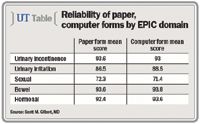Article
New tool may improve quality of life assessment in prostate cancer patients
Author(s):
A new computerized tool may solve the problem of the time and effort it takes to have patients fill out forms to assess quality of life.

Key Points
Chicago-Assessing a patient's quality of life has become an essential aspect of care, particularly among prostate cancer survivors, but filling out written instruments and evaluating respon-ses takes time that is seldom available while a patient is in the waiting or examination room. A new computerized tool may solve that problem, according to a study presented at the AUA annual meeting.

First author Scott Gilbert, MD, assistant professor of medicine at the University of Florida, said the endeavor was sparked by a 2005 Institute of Medicine monograph by Hewitt et al that identifies a number of shortcomings in the postoperative care of cancer survivors, including those with prostate cancer.
The researchers developed a computerized form of the standard Expanded Prostate Cancer Index Composite (EPIC). They then had patients complete both the paper and computer forms of the EPIC questionnaire prior to treatment. The reliability of the computer tool was assessed by comparing mean scores, standard deviations, and parallel form reliability coefficients between the paper and computer administration of EPIC.
Researchers found a high degree of reliability between the paper and computer tools across EPIC's five domains: urinary incontinence, urinary irritation, sexual function, bowel function, and hormonal symptoms. A separate survey found that more than 90% of patients were "highly satisfied" with the computer program.
"We thought that a computer-based tool would be more user-friendly," Dr. Gilbert explained. "The patient would answer the questions presented on the computer screen. The answers would be scored automatically and immediately populate a report. If the patient had completed previous questionnaires, the scores would be plotted on a graph that would illustrate the patient's recovery trajectory."
Dr. Gilbert said the intent of the project is to determine whether this immediate quality of life assessment has an impact on recovery.
"The study we presented was the first phase of a larger study consisting of 100 men who will use the computer system to complete the questionnaire. These men review their responses with a doctor or nurse practitioner and discuss them during the office visit. They will be followed for 12 to 24 months to map their recovery trajectory," he said.
Those curves will then be compared to the recovery curves derived from another 235 men who completed paper forms but did not have the opportunity to immediately discuss their results with health care personnel.
"We suspect that men completing the computer questionnaire might be more apt to have quality of life issues discussed with their provider and receive more timely interventions. We want to see if this then translates to more effective interventions, better recovery times, and higher levels of health-related quality of life benefits," said Dr. Gilbert.
Newsletter
Stay current with the latest urology news and practice-changing insights — sign up now for the essential updates every urologist needs.

